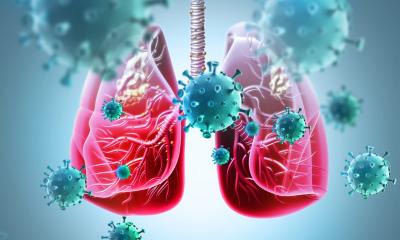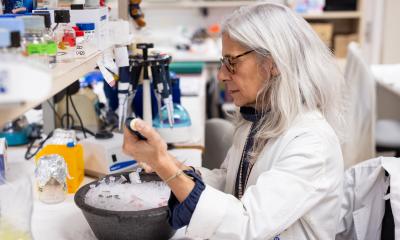Image source: PublicDomainPictures from Pixabay; edited: HiE/Behrends
News • Public transport
Down the tube: Is the Underground 'Covid safe'?
People travelling on the London Underground and similar rail systems were at a low risk of being exposed to the virus that causes Covid-19, according to computer simulations.
The modelling, carried out before the emergence of the Omicron variant, found that risks were reduced when ventilation was good and passengers complied with Covid-19 mitigation measures. These included wearing a face covering or mask; maintaining a social distance from other travellers; regularly washing or sanitising hands; and encouraging people who had Covid-19 symptoms to stay at home.
Scientists and engineers from the University of Leeds, the Defence Science and Technology Laboratory (Dstl) and the University of Manchester developed the model to identify the relative risks of the virus spreading on a mass transit system used for short commuter journeys. Professor Cath Noakes, from the School of Civil Engineering at Leeds and Principal Investigator on the study, said: “All environments where people interact together have a risk of virus transmission and public transport is no exception. Where journeys are short and not overcrowded, and the carriage is well ventilated, then the risks are likely to be quite low. Wearing a face covering can significantly reduce the risk of the virus spreading, particularly as it can be harder to socially distance in a Tube or subway carriage at certain times of the day. Even though there may be a small chance of transmission by touching a contaminated surface, this can be managed through regular hand hygiene and avoiding touching your eyes, nose and mouth. The results show that compliance with good mitigation measures is likely to be effective in reducing infection.”
The computer model simulated the risks of people being exposed to the virus through the main routes of transmission: being within two metres of an infectious person; touching a contaminated surface - and then touching their nose, mouth or eyes; or by breathing-in viral particles that hang in the air, known as aerosol inhalation. Presenting their findings in the journal Indoor Air, the scientists said: “...the risk of exposure to the virus was predicted to be low through all routes of transmission. The highest modelled doses (of the virus) were to a small proportion of people in close proximity to an infected person, which is through a combination of aerosol inhalation and direct droplet deposition.”
Recommended article

News • Team sports research
Coronavirus and soccer: study investigates transmission risk
A study by the Universities of Basel and Saarland shows that there is almost no risk of transmission of the Covid-19 virus on the field. They suggest that blanket quarantine measures for opposing teams are not justified if no close contact has taken place off the playing field. Governments have introduced various measures over the past 18 months in an effort to curb transmission of the Covid-19…
The scientists underline the effectiveness of continuing with well-established mitigation measures. They set out the practical steps passengers and transport operators could take to reduce the risk of staff and passengers being exposed to the virus:
- Covid-19 spreads more easily when people are close together, within 1-2 metres of one another. At times when Covid-19 infection rates in the community are high, measures to reduce crowding on public transport could reduce infection.
- The greater the number of passengers who are infectious, the greater the risks to other travellers. The researchers said public health policies should encourage people who are infectious to stay at home.
- High levels of mask wearing reduce the level of virus people are exposed to.
- The modelling also predicted that a small minority of travellers could be exposed to a large dose of the virus by touching contaminated surfaces. Hand sanitation facilities located near high-touch points, as people get on and off trains or near escalators, could reduce this risk.
The researchers added: “To date there is no evidence that public transport is a major driver for the pandemic but as a shared enclosed setting where people may be at close proximity, transmission is possible and understanding the factors that influence the likelihood of transmission is important for introducing and managing effective mitigation strategies. This is particularly important as public transport is a necessity for many people, and it can be an environment where social distancing is difficult to maintain, particularly in dense urban transport systems.”
Building a model of virus transmission for this environment requires a detailed understanding of the unique features of public transport spaces and how people use them
Simon Parker
On 27 January the Government in England lifted the mandatory requirement to wear a face covering in a range of settings, including public transport, but guidance suggests that they should be worn in crowded and enclosed spaces. However, the Mayor for London has said masks and face coverings will remain mandatory on all Transport for London services and in stations, including the Underground, unless travellers are exempt. In Scotland, Wales and Northern Ireland there is still a legal requirement to wear a face covering on public transport.
Dr Martin Lopez-Garcia, a mathematical modeller from the University of Leeds and co-author of the paper, said: “Measuring transmission on public transport systems is challenging. Our model provides an insight into the different factors that are likely to influence risk and should be used to effectively plan strategies that reduce the transmission of the virus.”
The computer model was developed independently by researchers as part of the £1.7 million TRACK project, funded by the Department for Transport and the Engineering and Physical Sciences Research Council. TRACK is a multi-strand investigation into the Covid-19 risks on public transport - buses, trams and trains - and the ways those risks could be reduced. Dr Simon Parker, a modeller from the Defence Science and Technology Laboratory (Dstl) and co-author, said: “Building a model of virus transmission for this environment requires a detailed understanding of the unique features of public transport spaces and how people use them. The results are complex but fascinating and, we hope, valuable. They reflect the interactions between disease prevalence, passenger behaviour and the environment itself.”
The research team point to the limitations of their model. It does not take account of vaccination rates among the travelling public, and the model was created before the arrival of the Delta and Omicron variants. The modelling did not analyse viral spread in very overcrowded carriages, which could be seen when large numbers of people return to their offices and workplaces. However, Professor Noakes believes mitigation measures will continue to reduce risks. She said: “The Omicron variant is more transmissible and the risks of exposure in different settings including on public transport are not yet clear. However, the mitigations identified in the study are still likely to be effective at reducing the risk of exposure to the virus.” Professor Charlotte Deane, Deputy Executive Chair of the EPSRC, said: “These findings demonstrate the value of developing models to assess how Covid-19 spreads, and are a valuable contribution to the evidence base. They also reinforce the point that measures such as wearing face coverings, good ventilation and hand sanitation are likely to play an important role in limiting the spread of the virus.”
Source: University of Leeds
14.02.2022











